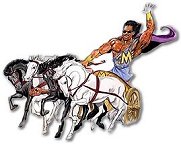|
Triton was a Greek sea demigod, a merman with the upper body of a
human and the tailed lower body of a fish. He lived with his
parents, the sea gods Poseidon and his wife Amphitrite, in a
golden palace on the bottom of the sea.
In Greek vase paintings he was shown sometimes bearded, other
times youthful. Later writers describe this deity as riding over
the waves on horses or other sea monsters.
He is often portrayed as a herald or messenger for Poseidon or the
great Oceanus, and usually depicted holding a conch shell that he
would blow like a trumpet to calm or raise the waves. It had such
a harsh and frightful sound that, when loudly blown, it would put
even the Giants to fight, who mistook it for the roar of a wild
and terrifying beast.
"There is a story similar to this about the shell of Triton. He,
too, when he had hollowed out the trumpet he had invented, took it
with him against the Gigantes (Giants), and there blew strange
sounds through the shell. The Gigantes, fearing that some wild
beast had been brought by their adversaries, took to flight, and
thus were overcome and came into their enemies' power."
Pseudo-Hyginus, Astronomica 2. 23
In later times, Triton became a generic name for mermen. He
sometimes bore a trident, similar to his father Poseidon.
Tritons were sometimes represented with two horse's feet instead
of arms, and they were then called Centaur-Tritons or
Ichthyocentaurs.
Though sometimes kindly, mermaids and mermen were usually
dangerous to humans. Their gifts often brought misfortune, and, if
offended, the beings caused floods or other disasters. To see one
on a voyage was an omen of shipwreck.
Triton was alleged to be a foster parent to the goddess Athena and
had a daughter named Pallas. A different Pallas was a male Giant
who was slain by Athena. He also had a daughter named Triteia.
"They say that after Athene's birth, she was reared by Triton, who
had a daughter named Pallas."
Pseudo-Apollodorus, Bibliotheca 3. 144
In the 2nd century CE, the Greek poet Pausanias described Tritons:
"The Tritons have the following appearance. On their heads
they grow hair like that of marsh frogs not only in colour but in
the impossibility of separating one hair from another. The rest of
the body is rough with fine scales just as is the shark. Under
their ears they have gills and a man's nose; but the mouth is
broader and the teeth are those of a beast. Their eyes seem to me
blue and they have hands, fingers and nails like the shells of the
murex. Under the breast and belly is a tail like a dolphin's
instead of feet.
Ovid, in Metamorphosis, tells us that:
"[After the Great Deluge had wiped out mankind :] The Lord of the
Sea (Rector
Pelagi)
[Poseidon] laid by his three-pronged spear and calmed the waves
and, calling from the deep Triton, sea-hued, his shoulders
barnacled with sea-shells, bade him blow his echoing conch to bid
the rivers, waves and floods retire. He raised his horn, his
hollow spiraled whorl, the horn that, sounded in mid ocean, fills
the shores of dawn and sunset round the world; and when it touched
the god's wet-bearded lips and took his breath and sounded the
retreat, all the wide waters of the land and sea heard it, and
all, hearing its voice, obeyed."
The largest moon of the planet Neptune, the Roman equivalent
to Poseidon, has been given the name of his son, Triton.

BACK HOME

|







